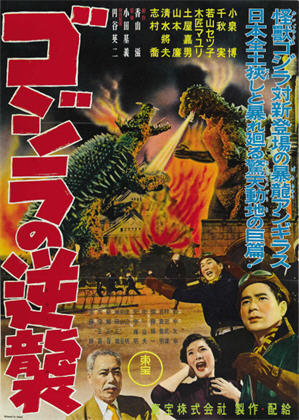
“This time, along with a second Godzilla, the new danger of Anguirus has surfaced. We are now facing a greater threat than that of nuclear weapons.”
[Original title: Gojira No Gyakushū]
[aka Godzilla Raids Again]
Director: Oda Motoyoshi
Starring: Koizumi Hiroshi, Chiaki Minoru, Wakayama Setsuko, Kasama Yukio, Shimizu Masao, Shimura Takashi, Tsuchiya Yoshio, Onda Seijiro, Sawamura Sonosuke, Nakajimo Haruo, Tezuka Katsumi
Screenplay: Hidaka Shigeaki and Murata Takeo
Synopsis: Two former air force pilots, Tsukioka Shoichi (Koizumi Hiroshi) and Kobayashi Kōji (Chiaki Minoru), work as “spotters” for the Kaiyo Fishing Company, based in Osaka. Out on patrol, Tsukioka locates a large school of bonito, and radios its position to his company’s head office. The message is relayed to the fishing fleet by radio operator Yamaji Hidemi (Wakayama Setsuko), who is the daughter of the company’s owner, Yamaji Koehi (Kasama Yukio), and also Tsukioka’s fiancé; the two make plans for dinner and dancing. Meanwhile, Kobayashi’s plane develops engine trouble. The pilot reports the situation and requests immediate assistance, adding that he will attempt an emergency landing by Iwato Island. Hidemi radios Tsukioka, who at once heads for Iwato. To his enormous relief, he finds that Kobayashi has managed to set his plane down safely, and is onshore. Tsukioka puts his own plane down on the water and joins his friend, building a fire as Kobayashi nurses his injuries from his rough landing. Suddenly, a strange roar echoes across the island. The two stare in terrified disbelief at its source: it is Godzilla. As the pilots watch, they see that the gigantic creature is locked in a deadly battle with a second monster that they do not recognise. The impact of the struggle brings rocks and debris showering down upon the pilots, who desperately try to find shelter. As they look on, they see the two creatures tumble into the sea… Back in Osaka, Tsukioka and Kobayashi report what they have seen to a meeting of government and police officials. In a book on dinosaurs, Kobayashi finds a sketch of a creature that resembles the second monster. It is the Ankylosaurus, also known as Anguirus, a dinosaur that lived during the same period as Godzilla. Zoologist Dr Tadokoro (Shimazu Masao) explains that Anguirus was an aggressive, fast-moving, carnivorous creature. Dr Yamane Kyohei (Shimura Takashi) is then called upon to address the meeting. He shows those gathered film of Godzilla’s devastating attack upon Tokyo, and expresses his fear that with the death of Dr Serizawa and the consequent loss of his oxygen destroyer technology, there is no way to stop this new threat. Yamane explains that this is not the original Godzilla, but a second member of the same species, also woken by atomic testing. Arrangements are made for surveillance flights to find the two monsters, in order to predict where they might come ashore, along with plans for evacuations and blackouts. Dr Yamane describes how, during the attack of the first Godzilla, it was observed that the creature was sensitive to bright lights, showing a tendency to head towards them; he suggests that flares might be used to draw this second specimen away from populated areas. Although Godzilla seems at first to be headed towards Shikoku, he then turns for Osaka Bay. The military defences take up their positions, while the blackout is enforced and the civilian population evacuated. When Godzilla appears in the waters of the bay, air force jets fire flares behind him. As hoped, Godzilla moves towards them; it seems at first that it will be possible to lead the creature back into open waters. However, at the same time, criminals being transported in a prison truck overpower their guards and make a break. Three of them hijack a truck that was transporting petrol. During the ensuing chase, the driver loses control of the truck: it slams into the buildings of an oil refinery. Within moments, the entire complex is engulfed in flames—and, out in Osaka Bay, Godzilla turns purposefully towards the shore…
Comments: With the success of Gojira, the executives at Toho did what studio executives always do, and hurried a sequel into production. So eager were they to capitalise on the unexpected financial windfall wrought by the first and greatest of the kaiju eiga that perhaps they not stop to consider exactly what it was that had made that movie such a success. Tsuburaya Eiji, who had masterminded the first film’s special effects, was re-hired, as was screenwriter Murata Takeo; but director and co-writer Honda Ishirō and composer Ifukube Akira were both engaged at that time on other productions.
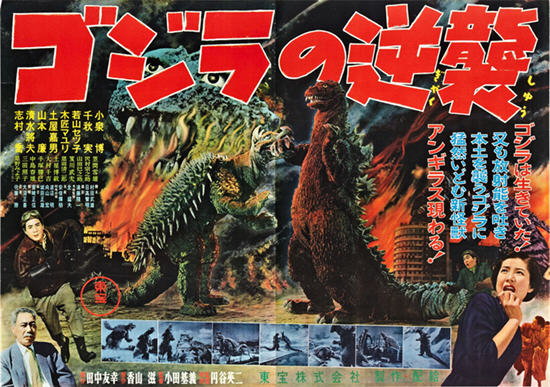
In their impatience, the executives did not wait for these crucial contributors to be once again available, but assigned their tasks to newcomers Oda Motoyoshi and Sato Masaru, respectively. Oda was a director known rather for his ability to finish a film quickly that for his vision; Sato would go on to become one of Japan’s leading film composers, but at the time was a newcomer with only a few previous scores to his credit, none of them for works of science fiction. The film’s budget was restricted, and its production rushed: Godzilla’s Counterattack premiered in April of 1955, only five months after its forerunner. The Japanese public turned out in droves for it, but they were not pleased with what they saw. The film was poorly received by critics and fans alike; and as a consequence, it would be another eight years before Godzilla appeared again in a motion picture…and by then, it would be a very different kind of motion picture indeed.
Godzilla’s Counterattack is not a bad film, but it is in every respect a much lesser film than its predecessor. It does retain the look and the serious tone of Gojira, but lacks that film’s grandeur, its visual and emotional power, and above all its allegorical aspects. Perhaps the difference between the two is best encapsulated in an examination of the later film’s human drama. Gojira explicitly evokes memories of war-time devastation, with its focus held at all times upon the human cost of the trail of disaster left in Godzilla’s wake; its characters, confronted with so overwhelming a catastrophe, devote little thought or time to their individual problems and desires.
In contrast, Godzilla’s Counterattack spends just as much time upon the personal relationships and travails of the employees of the Kaiyo Fishing Company, after its main factory and head office are destroyed during the first attack upon Osaka, as it does upon monsters themselves or the broader consequences of their actions. This is “realism”, yes, but realism at considerable cost to the film itself. This drastic narrowing of the story’s scope has the effect of dragging everything else down with it. Even the ultimate defeat of Godzilla feels rather anti-climactic. Indeed, the Godzilla of this film is not that of the first, the atomic bomb made flesh; instead, he’s “just a monster”…
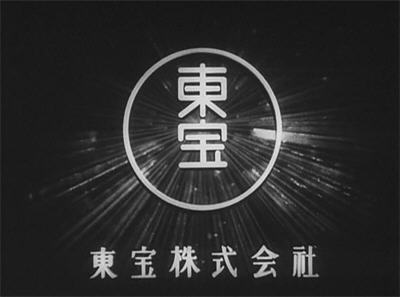
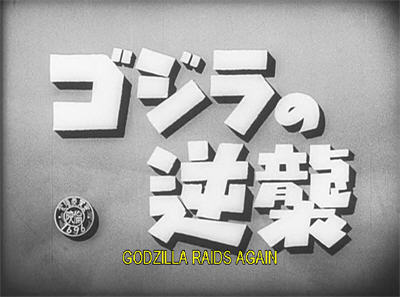
Rather than duplicating Gojira’s careful build-up to the first glimpse of its monster, Godzilla’s Counterattack takes the same approach as The Beast From 20,000 Fathoms – which, by this time, had screened in Japan – and includes monster footage in its opening sequence. Of course, this film does have a surprise up its sleeve, with its revelation that here there is not just one monster, but two! Downed pilot Kobayashi, and Tsukioka, his friend and rescuer, can only stare in horrified dismay at the creature they thought destroyed months earlier – so they assume it is – and then flee in terror as that monster engages another one, unfamiliar to their eyes, in violent battle. (The question of how Tsukioka, in particular, managed to fly a circuit of this island and not see the monsters until just now is left to our imaginations.) This first conflict concludes without resolution when the combatants fall from the edge of a rocky cliff and plunge into the sea. Safe for the present, Tsukioka and Kobayashi waste no time in returning to Osaka, to report what they have seen to the authorities.
Here we witness an amusing instance of the cultural divide. In Jaws 2, to take only one of many possible examples, Martin Brody yells, “Shark!”, and no-one believes him; here, Tsukioka and Kobayashi yell, “Godzilla!”, and almost before they know it, they find themselves in a meeting with military, civil and scientific authorities, debating what, if anything, can be done about this new threat to Japan—even though “the” Godzilla was comprehensively destroyed some months earlier. The two pilots look through sketches and books in an attempt to identify the second monster (another riff on The Beast…). It is Kobayashi who points out an armoured quadruped, which is identified by Dr Tadokoro, a zoologist, as Ankylosaurus, also known (he tells the others present) as “Anguirus.”
(A comment here: a number of different versions of this monster’s name have been used over the years, but “Anguirus” is the one included on the packaging of Toho’s official release of this film, so that’s what I’m going with.)
We learn that Anguirus was – is – 200 feet long; a fast, aggressive carnivore, capable of rapid movement and reaction thanks to a brain somewhat alarmingly described as being located, “In the breast and abdomen areas.”

Charmingly, the supposed source of Dr Tadokoro’s information – which is credited to the researches of one “Dr Preterry Hawdon” – is palaeontologist Edwin Harris Colbert’s The Dinosaur Book. Published in 1945, this was the first comprehensive publication on dinosaurs intended for the general public, and the root of many a dinosaur obsession. Although the point is not emphasised, actor Shimazu Masao is certainly handling a real copy of the book, and we are given a close enough look to see that the text is in English.
Of course, identifying the second creature is a fairly minor consideration. The meeting is then handed over to Dr Yamane (a cameoing Shimura Takashi, who appears in just this one scene), who has little but doom and gloom to offer, agreeing with Tadokoro that, “Our very worst fear”- namely, that continued atomic testing would give rise to more Godzillas, as Yamane warned at the conclusion of Gojira – has been realised. Yamane shows footage of the original Godzilla’s rampage through Tokyo, warning those gathered that the death of Dr Serizawa and the loss of his oxygen destroyer may mean that there is no way to stop this second Godzilla.
The one ray of light offered – literally – is Yamane’s observation that Godzilla reacts strongly to bright lights; he suggests using flares to draw the creature away from populated areas. This is agreed upon, along with the drawing up of plans for blackouts, and evacuation if necessary; and surveillance flights, in order to determine what area in Japan will be under threat from the monsters.
Needless to say, it never crosses anyone’s mind that the monsters might attack a country other than Japan, or not attack any country at all; and of course, they’re quite right. The air force surveillance flights spot both Godzilla and Anguirus moving towards Japan. They report this to defence headquarters—where, gloriously, the military higher-ups use little monster models to mark the creatures’ positions on the map. Their predicted destination is Shikoku (an island region to the south-west of Osaka), and the authorities put into effect their civil defence plans for that area.

Meanwhile, Tsukioka and his fiancée, Hidemi, belatedly act upon their own plans for dinner and dancing, in what would prove to be the first of many nightclubs scenes to appear over the history of the kaiju eiga. The two are slow-dancing when the public address system puts a crimp in their evening with the announcement that Godzilla has turned away from Shikoku, and is headed for Osaka instead; and that blackout will be enforced shortly. In what is soon seen to be a piece of unfounded optimism, the announcer asks that everyone move calmly towards the exit.
As the military forces take their place along the waterfront, and the flare-laden jets head out to sea, Osaka douses its lights. And not a moment too soon: Godzilla appears in Osaka Bay…
As the evacuation proceeds at pace, the jets drop their flares. Godzilla watches their tracks in the night sky, then turns to pursue them—knocking over a lighthouse with his tail in passing. As the defence forces look on with growing relief, their adversary begins to move back out to sea.
Tsukioka takes Hidemi to her father’s house up in the hills over Osaka (it’s her father’s car, but he’s driving), where they believe she will be safe. They find Kobayashi there; he tells them that Mr Yajimi has gone to his factory in the city. Concerned for his safety, both Kobayashi and Tsukioka head out to join him. After they have done so, one of Yajimi’s other subordinates reports the success of the flare-decoys, and Yajimi allows himself to believe that Osaka will be spared.
Fate, however, has other ideas.
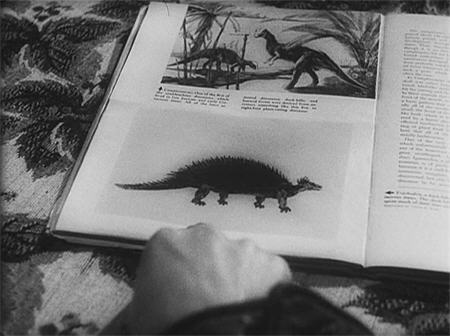
Among those being evacuated earlier were a bus-load of prisoners from the local jail. In a display of trust that they will shortly regret, the guards have left their charges entirely unsecured. A scuffle, three gunshots, and some squealing brakes later, the prisoners scatter with the guards in pursuit. One of the escapees is shot and injured; he is recaptured, along with two others who stopped to help him. The others split into two groups, one of which commandeers a parked truck—which has CALTEX emblazoned upon its side.
The guards in pursuit flag down a passing car – it just happens to be that driven by Tsukioka – and set out after the truck. The chase (which in terms of speed gives the one in Mitchell a run for its money) proceeds through the industrial district on Osaka’s waterfront, and is joined by a police car, sirens blaring. Tsukioka, however, sees danger ahead and hits the brakes; while the escapees are unable to control their vehicle. They take a sharp corner and head straight for a dead-end; the truck crashes through a wall and slams straight into the Osaka oil refinery…
The refinery erupts in flames and a series of explosions. Out in the bay, Godzilla’s head snaps around. Immediately, he abandons those tantalising flares and heads straight for Osaka City.
Along the waterfront, the soldiers fire their most powerful weaponry at Godzilla; the jets stop dropping flares and start firing missiles. It is all to no effect. Unmoved by the attacks upon him, Godzilla gives a roar and then blasts a passing jet with his breath, sending it plunging into the sea in flames…

And then, just when the Osakans thought things couldn’t get any worse, Anguirus trundles ashore. The two monsters bellow at one another in anger and hatred, and plunge immediately into battle. The jets continue to fire their missiles at the enraged creatures, while the ground forces very sensibly take advantage of their mutual distraction to retreat. At the factory, to which the flames are drawing very near, Mr Yajimi’s employees beg him to abandon the building and withdraw, which he reluctantly does.
The fight between Godzilla and Anguirus is a desperate, vicious affair, in which Anguirus often seems to have the upper hand. At one point, Godzilla is knocked onto his back, while Anguirus takes advantage of the moment to plunge his teeth into his adversary’s throat. The two charge, stagger and recover, engaging one another again and again, as around them building after building after building crumbles in their mutual wake.
Meanwhile, the last three of the escaping prisoners, caught in the middle of this titantic battle, take refuge in the subway. Wrong.
At last, the fight between Godzilla and Anguirus carries both creatures into the grounds of Osaka Castle. They pause there, gathering their strength, before Godzilla succeeds in fastening his teeth in Anguirus’ throat. As Anguirus emits high-pitched cries of pain, the two struggling monsters topple over—obliterating 350 years’ worth of history in the process. Godzilla then delivers a vicious bite, possibly a death-bite, to the back of Anguirus’ neck, before pushing him into the water, and putting an end to the conflict with a blast of his fiery breath…
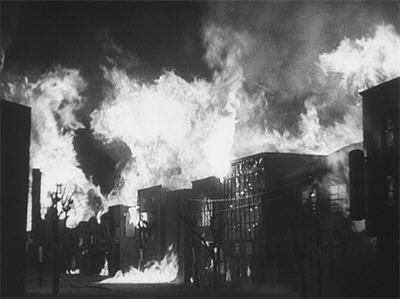
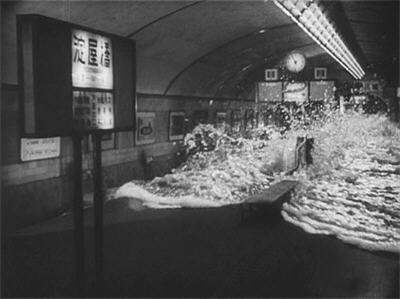
Local news announcers take a good news / bad news approach to the situation. Anguirus is dead, and Godzilla has headed back out to sea; but as for Osaka, well…
It is the next section of Godzilla’s Counterattack, following from the excitement of the monster battle, which tests the viewer’s patience. Godzilla is offscreen for the next fifteen minutes or so, as the employees of the Kaiyo Fishing Company count their losses, Tsukioka and Hidemi consolidate their relationship, and Koyobashi decides he wants a girlfriend. Now, none of this is terrible, but it’s not really what you want in the middle of a kaiju eiga; and particularly not when you compare this film’s trivial character issues with the profound ethical dilemmas that confronted the characters of Gojira.
Anyway, the upshot of this section of the film is that most of the characters are re-located to Hokkaido, where Mr Yajimi’s secondary plant is situated. An evening’s entertainment at a restaurant sees one dining-room occupied by Tsukioka and Kobayashi’s old air force buddies, including their former commanding officer, Captain Terasawa, and their good friend Tajima, and the other by the management of the Kaiyo Fishing Company. (Kobayashi manages to attend both dinners, and consumes much saké in the process.) Both parties come to a grim conclusion when news of the sinking of one of his ships by Godzilla reaches Mr Yajimi. The air force officers are ordered back onto surveillance duty, with Tsukioka and Kobayashi joining in the hunt for Godzilla in their company floatplanes.
From head office, Hidemi radios Tsukioka the report of a severe weather front, ordering him back to base. He insists on going on, however. Kobayashi is talking with Hidemi, obliquely intimating that he has, at last, found that elusive girlfriend, when Tsukioka radios in excitedly to report that he has spotted Godzilla and is pursuing him. Kobayashi interrupts Hidemi to demand to know how much fuel Tsukioka has left. When Tsukioka admits that he has only just enough to get back, Kobayashi tells him that he will fly in and relieve him. He hurries away instantly, leaving his pocketbook behind him. Hidemi opens it, and finds inside a photograph…
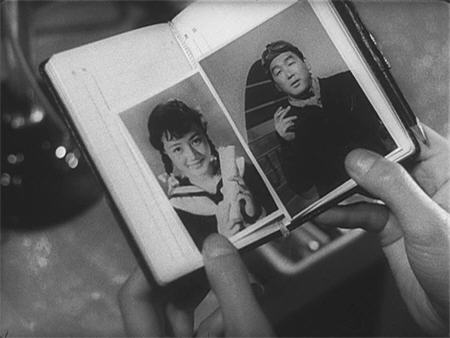
And tragically for Kobayashi, this glimpse of a photo of his girl will turn out to mean exactly the same thing here as it would in a Western film.
Tsukioka’s report also sends the air force scrambling. Meanwhile, Tsukioka himself is still in the air, keeping watch over Godzilla who has come ashore on a small, icy piece of land called Kamiko Island. (No explanation is provided for Godzilla choosing this chilly wasteland.) To his relief, Tsukioka sees Kobayashi approaching, and heads home.
Back at the naval base, Tsukioka reports to senior command, drawing a map of Kamiko Island to indicate Godzilla’s position—and how, possibly, they can trap him there, by closing a narrow passageway in the rocks. Captain Terasawa of the Special Defence Force orders his men to transport barrels of gasoline to the island by boat, in order to create a wall of flame that hopefully will slow Godzilla’s movements until more definite action can be taken against him.
However, as Kobayashi has seen, Godzilla is already showing signs of leaving Kamiko Island. Determined to keep the creature there until the fighter planes arrive, Kobayashi resolves on the dangerous course of “buzzing” Godzilla, keeping him distracted by flying down into the canyon that contains him and out again. The air squadrons arrive, with Tsukioka riding in his old colleague Tajima’s plane. The squadron drops bombs on and around Godzilla, which has no effect but to anger him. Tajima, leading the attack, concedes its ineffectiveness.

Kobayashi, refusing to give in, turns his plane once more towards the island, but this time the enraged Godzilla is ready for him. Godzilla’s breath clips Kobayashi’s plane as it passes. It catches fire, plunging towards the icy cliff face, where it crashes and explodes, sending chunks of ice rolling down into the canyon…
But even as Tsukioka cries out in anguish over his friend’s death, he realises that Kobayashi has inadvertently shown them the way that Godzilla can be defeated. He passes on his idea to Tajima, who orders the bombing of the cliffs, in an attempt to create an avalanche that will bury Godzilla. However, the angle of the attack is wrong, resulting in failure. Tajima orders his own squadron back to base to re-arm, leaving the others to keep Godzilla under observation.
Back at base, Tajima illustrates for his men the way that the attack must be carried out, in order to have the effect they need: a dangerous flight in towards Godzilla, and a sharp climb out afterwards. When the announcement comes that the planes have been re-loaded, Tsukioka begs to be allowed to take part in the mission, to which Captain Terasawa agrees.
As the naval force works on creating a flame-barrier at the canyon’s mouth, Tajima’s squadron begins its critical bombing raid. Plane after plane swoops in and climbs out, firing their missiles into the steep cliff faces and sending showers of ice and snow down upon Godzilla. Still, the creature is free to move, and to strike back; more than half of the squadron meet a fiery end.
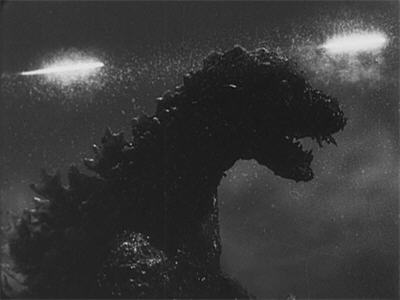
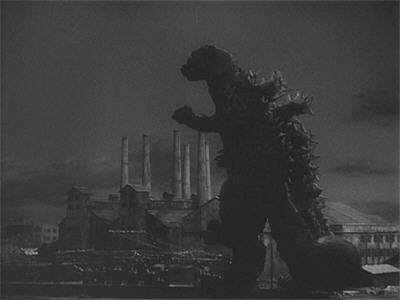
Despite these losses, the tactic is a success. Godzilla is trapped within the ice that hurtles down the cliffs at him, and unable to extricate himself. As his despairing cries echo through the canyon, Tsukioka turns his plane for the final approach. He fires his missiles, and one final shower of ice buries the creature altogether. The survivors of the mission celebrate its success, while a tearful Tsukioka has the final word: “Kobayashi…”
Godzilla’s Counterattack is often a frustrating experience. The film is good but, with the shadow of its predecessor looming over it, not good enough. The retention of a serious tone, and the black-and-white cinematography, makes the viewer expect more of this production than it can deliver, or indeed even tries to. One of its main failures is its inability truly to integrate its characters into its story. Mr Yajimi and his employees are certainly victims of the monsters’ destructive behaviour, but that is true of everyone in Osaka; there is no particular reason why we should care more about these people than anyone else. Even the contributions of Tsukioka and Kobayashi seem forced, with the two pilots – and they alone – thrusting themselves upon the Special Defence Forces.
(This is monster movie logic at work, of course, which dictates that the first people to spot a monster must continue to play a role in every aspect of the story.)
Perhaps the greatest letdown, however, is the shift in the story’s action. Instead of dealing with the aftermath of the monsters’ invasion, as Gojira does, Godzilla’s Counterattack sees its characters swiftly abandon the ruined Osaka for a new life in Hokkaido. Although we briefly see some clean-up of Mr Yajimi’s ruined head office, there is absolutely nothing in this film to match, say, Gojira’s scenes of Emiko working as a nursing volunteer amongst the casualties of Godzilla’s destruction of Tokyo. In its dismissive attitude to the consequences of its monsters’ actions, Godzilla’s Counterattack points the way towards the less serious Godzilla films of the future.
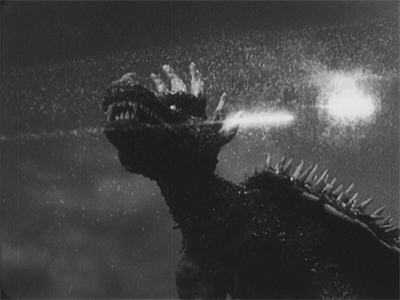
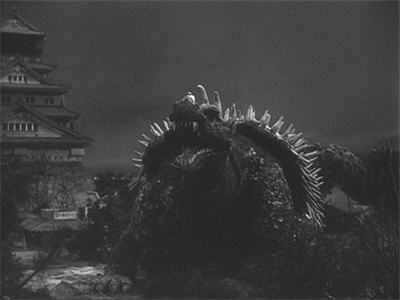
Of course, one major reason why we might have no scene set amongst the casualties of Godzilla and Anguirus’ battle is that there hardly are any! This aspect of the film puts me in a bit of a bind. I’m always insisting upon realism and internal logic in fantasy films, yet it is undeniable that the film’s attempts to provide them here work against it. What we find in Godzilla’s Counterattack are characters who really have learned from their experiences. As the monsters approach, Osaka is swiftly and thoroughly evacuated; while the military forces guarding the waterfront do not hesitate to retreat when their efforts prove in vain.
The upshot of all this efficiency – and pragmatism – is that while Osaka City itself is obliterated, the only human victims of the monsters’ rampage are the three escaped prisoners who try to find refuge in the subway. And even at the conclusion of the story, the casualty count is astonishingly low. We know that Godzilla has destroyed one of the fishing fleet’s ships, but that occurs off-screen; while the final battle sees the deaths of five fighter pilots, and of course of Kobayashi. Without meaning to sound ghoulish, the minimal death-toll in this film makes it far easier to react to it merely as an entertainment, rather than as a serious drama. That said, it is very probable that the scenes of the fighter planes crashing and burning had a profound effect upon Japanese audiences of the time. The same is true of those moments when Hidemi gazes out of the windows of her hilltop home, to see Osaka City engulfed in flames.
One of the real strengths of Godzilla’s Counterattack, not unexpectedly, is the special effects work of Tsuburaya Eiji – and all the more so, when you consider the film’s horribly brief production schedule. The devastation of Osaka is yet another fine example of the work of Tsuburaya and his team, containing any number of brilliant and vivid images. What is most impressive, however, is the obvious attempt not merely to reproduce the powerful visuals of Gojira, but to create new ones as well. Most notable are the two most physically opposed effects sequences: the fiery eruption of the oil refinery, and the flooding of the underground railway station. The latter, in particular, stands out both for its originality, and the sheer ingenuity of its execution, considering the melding of different techniques that must have gone into its creation.


Successful as these scenes are, the most important piece of practical effects work here is the demolition of Osaka Castle. This is a significant moment in the history of the kaiju eiga: the destruction of a famous landmark simply for its own sake; in fact, I would not be at all surprised to learn that Godzilla’s Counterattack was set in Osaka specifically so that the castle could be destroyed.
This scene marks a profound shift away from the philosophy that underpinned Gojira. In that film, although the Diet Building and the Wakko Building clock tower both fell during the monster’s rampage through Tokyo, it was treated merely as collateral damage; there was no dwelling upon those incidents, far less any lingering to enjoy the moment. In Godzilla’s Counterattack it is otherwise. Here again, we find foreshadowing of the attitude of certain Godzilla films of the future, where the ruination of a country’s cultural heritage would not be a tragedy, but just a bit of childish fun. The very staging of Osaka Castle’s fall, with a very calculated delay before the inevitable collision of monsters and history, indicates that the audience is not supposed to take it seriously, but rather just enjoy the sight.
The destruction of Osaka Castle forms the climax to what is, in historical terms, certainly the single most consequential aspect of Godzilla’s Counterattack: the central fight between Godzilla and Anguirus. There are many moments in this film where Oda Motoyoshi’s handling of the action, and his practical choices, leave much to be desired. For one thing, Oda tampered with the puppet that plays Godzilla in close-up, giving the monster larger, more fang-like teeth. These, however, did not fit within the puppet-head’s mouth, leaving Godzilla looking goofy rather than threatening (or at least in need of a good dentist). Whereas Honda Ishirō chose to stage many of his scenes at night, both in order to disguise any shortcomings in the special effects and to heighten the visual impact of Tokyo in flames, Oda if anything over-lights his action, making much of the film’s wire-work, that controlling the miniature planes and the movement’s of Godzilla’s tail in particular, only too obvious. At the same time, the shots of Godzilla and Anguirus in Osaka Bay, surrounded by drifting flare-lights and flak from the firing of the guns, are truly beautiful.


Perhaps the greatest change, however, comes in the filming of the fight scenes. In Gojira, the monster scenes were routinely over-cranked, smoothing the action and giving an ominous majesty to the creature’s movements. Here, in contrast, much of the monster footage was under-cranked—that is, sped up. Oda reportedly made this choice to highlight the power and aggression of the battling behemoths, but the result is not entirely successful. The rapidity of the creatures’ movements has the opposite of the desired effect, shattering suspension of disbelief. During the opening scene, in particular, we do not really see Godzilla and Anguirus locked in violent conflict; instead we see—well, two guys in rubber suits, whaling on each other.
The monster fight in Osaka is, however, another matter entirely. This is a very different kind of fight from those that would feature in subsequent kaiju eiga. Many of those later monster battles are quite light-hearted affairs, like the films that contain them; while even the more serious ones tend to feature battle scenes where the action has obviously been carefully choreographed. In Godzilla’s Counterattack, it is far otherwise. The fight between Godzilla and Anguirus is a brutal affair whose power lies very much in the sheer crudity of its execution. There is no anthropomorphism lurking in this sequence, no martial arts moves or other human gestures. Instead, for once, what we have here is two animals, instinctively and violently intent upon each other’s destruction. They snarl, and claw, and bite. Godzilla takes quite a beating here, before belatedly gaining the upper hand: his bloody mauling of Anguirus’ neck, as his defeated adversary cries out in agony, is a moment not easily forgotten.
(The Godzilla and Anguirus suits in this film were occupied by, respectively, Nakajima Haruo, Toho’s leading suit-actor for the next two decades, and his main professional rival at the time, Tezuka Katsumi; an arrangement that no doubt added to the enthusiasm of the fight scenes.)
Effective though this sequence is, its positioning in the middle of the film is problematic. The film’s actual climax is less successful (partially dramatically, partially because of its inclusion of a non-moving Godzilla model); while the long stretch of character scenes that follows the monster battle seem even flatter and less interesting in the wake of the mid-film eruption than they are in actuality
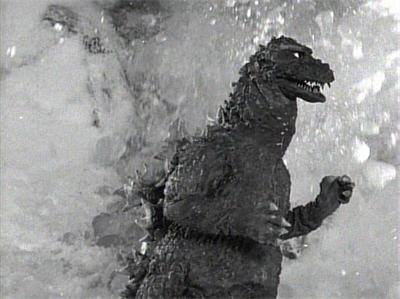
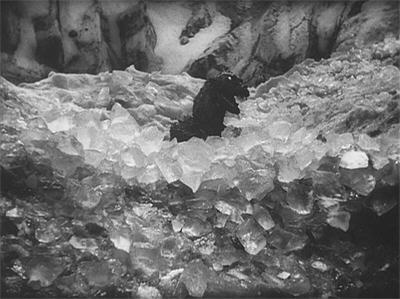
Nevertheless, the invention of the monster fight would turn out to be Godzilla’s Counterattack’s legacy to posterity. Not all, but most, of the kaiju eiga made subsequently would feature a battle between two or more monsters, very often building towards it as the climactic highlight of the story. Indeed, there are a number of kaiju eiga that are inconsequential except for the entertainment of their monster fights. These films are a far cry from the gravity and serious intentions of Gojira – so much so, that it is hard for those of us who love that film with a real passion not to feel a certain sense of betrayal at the direction taken by its descendants. However—
Well, here’s the thing: Gojira was lightning in a bottle, a unique melding of personalities and philosophies that gave rise to a work of irreproducible power and emotion. Despite Dr Yamane’s grim warnings at the end, Gojira is also a very complete film; dramatically speaking, there was no need for a sequel. The chief importance of Godzilla’s Counterattack is not its extension of Godzilla’s story, but the way that it functions as a bridge between the sombre, brilliant film that preceded it, and the more frankly entertaining works to come.
(In this respect, Gojira and Godzilla’s Counterattack may be directly compared to their American counterparts, Destination Moon and Rocketship X-M: the one, a serious, successful, self-contained work; the other, a cheaper and far less artistic knock-off that would nevertheless inspire any number of subsequent productions.)
While the later kaiju eiga cannot match their progenitor in terms of drama or impact, they all – well, most – have virtues of their own; and I for one wouldn’t part with any of them. And let us not overlook the fact that for every comical monster brawl of the future, there would be another that formed the climax of an exciting and serious work of science fiction. For this, if for nothing else, Godzilla’s Counterattack’s place in history is secure.
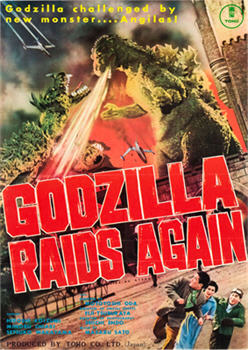
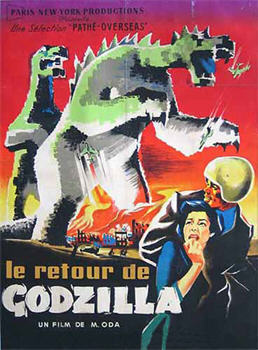

________________________________________________________
But wait! There’s more!
Like Gojira, Godzilla’s Counterattack eventually made it to American movie screens, albeit in drastically altered form. The latter’s journey, however, was a long and tortuous one. The initial plan, concocted between Toho and the small group of producers (or, at least, wheeler-dealers) who had already turned Gojira into Godzilla, King Of The Monsters!, was for the effects and action sequences of Godzilla’s Counterattack to be cannibalised, and used as the basis of an American monster movie to be called The Volcano Monsters. Amongst those assigned to work out how this footage could be integrated into a new storyline was Ib Melchior, whose first film assignment this was. The scheme had progressed far enough for Toho to ship the Godzilla and Anguirus suits to the US, so that new footage could be shot using them, when AB-PT Pictures, the small company that was to produce and distribute The Volcano Monsters, went bankrupt. The project was consequently abandoned. The monster suits were never shipped back to Japan and, horrifyingly, later went MIA.
Godzilla’s Counterattack did, however, finally reach the American people—sort of. The same association, headed by Paul Schreibman, took hold of the Japanese film and re-worked into something that they considered more appropriate for American audiences. The result, re-titled Gigantis, The Fire Monster, was released in the US during May of 1959.
________________________________________________________

.
GIGANTIS, THE FIRE MONSTER (1959)
.
“This is bad. This IS bad.”
If Godzilla, King Of The Monsters! is the best and most respectful example of all the many Americanisations of Japanese science fiction films, then Gigantis, The Fire Monster is one of the very worst. This film’s insulting of its audience begins with its title. It was the decision of Paul Schreibman to pretend that this wasn’t a Godzilla film, the intention being to “avoid confusing the audience”. Not surprisingly, the scheme backfired: monster fans, confronted by Godzilla in what wasn’t supposed to be a Godzilla film, were very confused indeed. Given the success of Godzilla, King Of The Monsters! in the US, Schreibman’s evident reluctance to associate the latter production with its predecessor is mystifying.
As to the rest, it is hard to know where to start. There is no change made to the original film that isn’t ill-judged and embarrassing. Here’s rundown of just some of the shortcomings of Gigantis, The Fire Monster:
Stock footage, and plenty of it: – well, what would an American science fiction of the fifties be without it? Atomic bomb tests and rocket launches; scenes of Japan more in keeping with stereotypical opinions; and American nightclubs are just a few of the new sequences imposed upon Godzilla’s Counterattack. Ludicrous “science-y” inserts are appended to the grim footage of Godzilla’s attack upon Tokyo from Gojira. Consensus is, these were culled from educational films of the time; and ridiculous as they are, it is hard to hate these sequences, particularly considering their plasticine brontosauruses, and the adorable prehistoric mud puppy.
Turning non-Japanese: – Gigantis, The Fire Monster is dubbed—badly. On the upside, it’s a case of The Usual Suspects: most of the voices are provided by Keye Luke, George Takei, Paul Frees and Marvin Miller. On the downside, the script is just awful, coming up with any number of ridiculous phrases to try and match the Japanese lip movements. Most notoriously, Tsukioka’s exclamation of, “Bakayara”, meaning roughly, “You dummy”, is translated as, “Ah, banana oil!”—a piece of idiocy understandably seized upon by the critics of the day. Other inexplicable moments include the re-working of a scene between Hidemi and her work-mate, Yasuko, where instead of teasing Hidemi over her romance with Tsukioka (and not-that-seriously reproving her for conducting it on company time), Yasuko now exclaims, “Kiss me again, I’m all yours!”
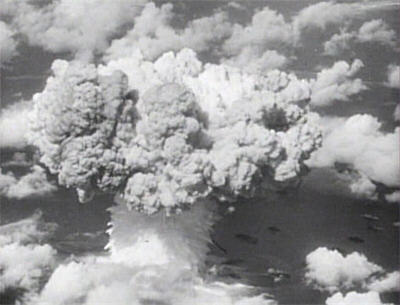
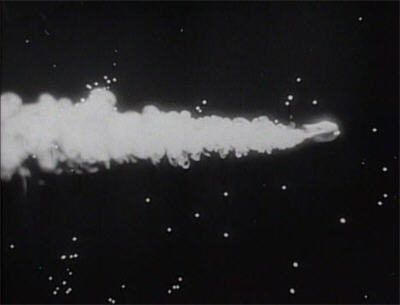
However, what Gigantis does to Kobayashi is not funny at all. Godzilla’s Counterattack actually has joint heroes, with Tsukioka and Kobayashi playing equally significant roles in the action. It is Kobayashi who gives his life to help defeat Godzilla, while Tsukioka delivers the coup-de-grace and the eulogy. However, either the producers of Gigantis didn’t feel that there was room in the film for more than one hero, or Chiaki Minoru, with his somewhat chunky build and moon-face, didn’t fit their preconceptions of what a hero “should” look like. They responded by having Kobayashi dubbed (probably by Marvin Miller) in a goofy, dumb-guy voice that forcibly turns him into the Odious Comic Relief.
Shut up, just shut up!: – one of the most painful changes made was the inclusion of narration by Tsukioka (delivered by Keye Luke), which just – won’t – stop. It is also incidental to an agonising degree (“Kobayashi waved at me,” says Tsukioka, as Kobayashi waves at him). The only parts of the film lacking this voiceover are the special effects sequences, which were carried over intact from the original film; another reason to love them.
Nutty narration: – Marvin Miller strikes again. As is the stock footage, so is the narration. Gigantis opens with a pompous voiceover that – apart from a rather insulting reference to Japan as “a little nation” – segues weirdly from reflections upon, “Man’s scientific journey along civilisation’s strange and terrible road” to asserting that Man is, “Seeking answers to worlds outside his own.” Eh? “Are there not darker and more sinister secrets on this planet, Earth, still unanswered, still baffling and defying man? With each step forward, does he not take two steps back!?” Mr Narrator then gibbers, as the rest of us back slowly away from him, our hands held up placatingly.
What film is that?: – apart from the stock footage and the educational films, Gigantis also pinches scenes from other movies; the meteoroid strike also seen in Robot Monster is probably the most recognisable of these snippets, although the rubber-suit tyrannosaurs from Unknown Island also get a look in.
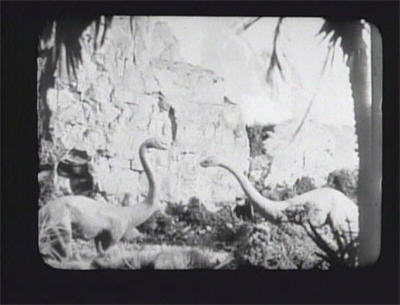
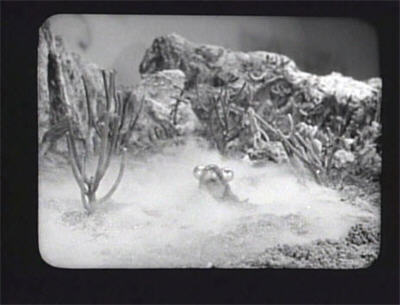
Sato Masaru, who?: – most of the film’s original score is gone, replaced by library music and excerpts from the scores of contemporary American science fiction films including It! The Terror From Beyond Space and Kronos. Sato’s work is now confined to the special effects scenes, where it was too much trouble to remove it.
If it doesn’t happen to America, it doesn’t matter: – giant monsters are attacking Japan: pretty boring stuff, huh? The producers of Gigantis thought so, including footage suggesting that the monsters might actually have the temerity to – gasp! – attack America. Because of course, if it isn’t happening to Americans, then why should anyone care?
Spinning newspaper injures printer: – as usual, news is conveyed to the viewer via the age-old technique of the spinning newspaper; and also as usual, the banner headlines that these papers carry are less interesting than the smaller ones further down the page. While the American papers all seem obsessed with taxation, the Osaka Times – apart from reporting the sighting of Gigantis – informs us about that New French Cabinet Upheld By Deputies, Engineers Finish 10-Year Research (I’m glad about that!), and above all, New ‘Living Buddha’ Reported Discovered (!); as well as listing the shipping arrivals and departures, which under the circumstances, I’d’ve expected to be cancelled…at least in Osaka…
A few philosophical differences: – one of the major alterations made to Godzilla, King Of The Monsters!, apart from the insertion of Raymond Burr, was the careful pruning away of Gojira’s anti-nuclear sentiment. Gigantis takes a slightly different approach to the issue, repeatedly assuring the audience that these monsters are much worse than any old atomic bomb. So there. We further learn that science, and science alone, is responsible for the dropping of bombs, and the firing of missiles – funny, I had an idea a few other people were involved in that – and also that the Japanese can expect no help at all from science in the current crisis, to which the only solution is prayer, and plenty of it. Stock footage of some Japanese people doing just that is then cut in—necessarily, since none of the original characters were seen doing anything of the kind. Possibly, however, none of this is really science’s fault. During the post-monster sighting conference, Dr Tadokoro consoles us with the assurance that, “Every lesson we’ve ever learned has told us this: that horrors in the world of science are part of Nature’s plan!”
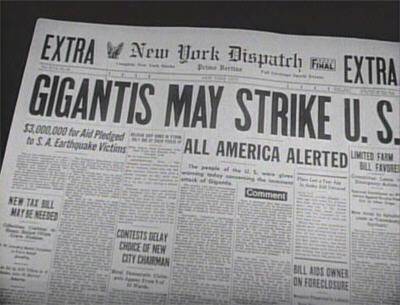
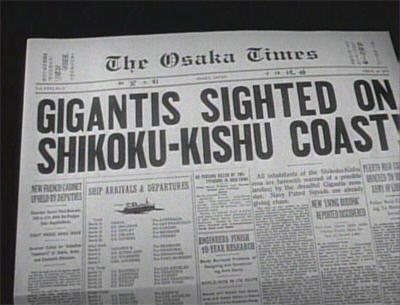
Anguirus gets a new agent: – few things in Gigantis are as bizarre as its introduction of Anguirus. Apart from containing some of the film’s most ridiculous dialogue, this section of the film informs us that the Ankylosauruses – or Anguillosauruses – or Anguiruses – were, “Murderers! Original, plundering murderers! – who killed everything in their way!” This information, by the way, is culled from, “A new book, from which we have learned so much” – no less than that runaway best-seller, Anguillosaurus, Killer Of The Living. Look for it in Oprah’s Book Club. Its vivid description of Anguirus is only one of the treasures to be found within this tome, which also explains how the dinosaurs, including Gigantis and Anguirus, did die out at all, but went into intentional hibernation—secure in the knowledge that, one day, they would be revived by nuclear fallout.
You say “Gigantis”, I say “Anguirus”: – in the end, nothing shows the contempt in which Paul Schreibman and his fellows held both Godzilla’s Counterattack and the paying public more completely that the treatment of the monsters in Gigantis. They don’t even bother to keep straight which monster is which! Gigantis is, successively, referred to as, “a Gigantis”, as “the Gigantis monster of the Anguirus family”, and as “the first Anguirus”. And as if that injury isn’t quite enough, the crowning insult comes during the monster fight scenes, wherein they mix up the monsters’ cries! Thus, Godzilla’s trademark roar issues from Anguirus, while Anguirus’ own, more high-pitched shriek, emanates from Gigantis / Godzilla.
In short, Gigantis, The Fire Monster is an excellent example of how to take a pretty good movie and turn it into a pretty bad movie. It isn’t entirely worthless, inasmuch as the special effects footage from Godzilla’s Counterattack are carried over wholesale, and that some of the new dialogue is hilarious in its ineptitude; but as always, if you can get access to the original version of the film, do so by all means.
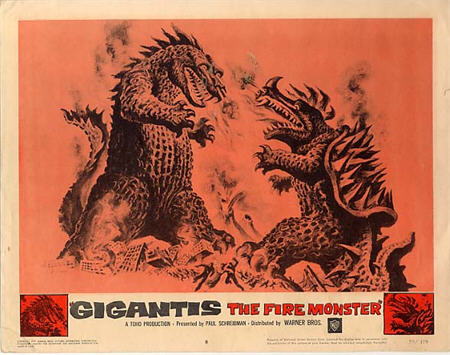
Footnote: And I can’t let Gigantis go without noting this image—
In-film, it’s supposed to be a map of “alarm” over the monsters spreading across the world, but to me it looks like…a map of something else…
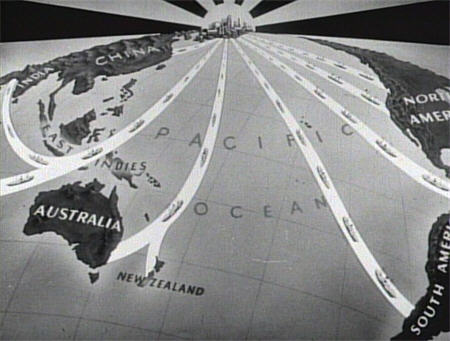

Thank you ever so much for addressing the butchery and contrast of the Americanized version. Most every time I’ve seen this movie its the Gigantis version and it is soooo horrible. And the near endless narration over most of the film, were they trying to save money by limiting the other artists speaking?
LikeLike
Welcome! 🙂
These reworkings are notorious for hiring the least possible voice-actors, and then containing more dialogue than the original. As a matter of fact I’m in the middle of wrestling with another example of it right now…
LikeLike
Hmmm….. Does this mean you’re going to run down the ENTIRE Godzilla franchise?
LikeLike
She did the entire Amityvill franchise, for which she should get a medal (or at least PTSD counseling). I would think Godzilla would be a piece of cake in comparison.
LikeLike
You have to understand—eventually I’m going to do the entire EVERYTHING. 🙂
And actually, Dawn, I have two more Amityville films to go, and possibly another one next January (if they EVER get around to releasing it; can it be that much worse than its predecessors!?).
LikeLike
“While the later kaiju eiga cannot match their progenitor in terms of drama or impact, they all – well, most – have virtues of their own; and I for one wouldn’t part with any of them.”
I take it the metaphorical dubious eyebrow-raising in that sentence is in the direction of Godzilla’s Revenge, eh?
I didn’t see Counterattack until it appeared on sharing a disc with Gigantis, and saw them effectively back-to-back, starting with the Americanization. The original looked VERY good by comparison, so I have to strain a little to understand the truth of people saying it’s not such a great film. I suspect this handicap is better than what I would have been afflicted with watching them in the other order; moments of cognitive dissonance are a lot easier to shake off than flinging oneself under a bus from sheer despair.
LikeLike
Wellll… 🙂
Yes, that sounds like the best way to see Godzilla’s Counterattack. What you don’t want to do is watch it too close to Gojira, which is kind of the Gigantis / GC situation in reverse.
LikeLike
I certainly understand the near-universal disregard for Revenge, and while it’s not among my favorites, I did see it young enough to appreciate it being a highlight reel of monster scenes (a couple of which I’d not seen previously), and to somewhat care about the protagonist. That said, it’s been a very long time since I last saw it. I do plan to give it to my nephew for Christmas, though, as he’s young enough that I’m sure he’ll appreciate it; and let’s face it, it is most definitely a kids’ movie.
I, too, had my appreciation for this movie increase when I got to see the original and compare it to the Americanized version. I’m forever in debt to Classic Media for their DVD release of this (not to mention all their others).
To be fair, you really shouldn’t watch any other giant monster movie in close proximity to Gojira, not just this one; it will do none of them any favors.
LikeLike
By the way, I love that you include posters for the movie from around the world…..
LikeLike
That’s one of my favourite things too so I will always try to. 🙂
LikeLike
Love your take on the Godzilla films. Can’t wait for your King Kong vs. Godzilla piece.
LikeLike
Thanks, Ed!
Yeah, thanks for bringing that up, Rev! 😀
It will happen, but it will be a while. There will be other things first.
LikeLike
Reblogged this on Mike's Movie & Film Review.
LikeLike
The ankylosaurus “was an aggressive, fast-moving, carnivorous creature.” Yes, well. Were small boys not dinosaur geeks in Japan in the 1950s?
I love gc55-map1b (just after “into the sea in flames”). Of course, after the first attack the Godzilla cutout would have been added to every military situation room.
LikeLike
Apparently not. Nor did they realise that small boys (and, ahem, girls) elsewhere were.
Yes, at least they listened to Dr Yamane about *that*.
LikeLike
Fair point, I was assuming they weren’t trying to sell the film to small girls at all.
LikeLike
No-one tries to sell anything worthwhile to girls. This doesn’t mean they aren’t interested.
LikeLiked by 1 person
I love your reviews of the original Japanese Gojira films. I wonder what your thoughts are regarding Shin Gojira.
LikeLike
Thanks, Michael! Unfortunately I didn’t get to see it: it had a brief cinema release here and I couldn’t work around my commitments at the time to get to it. Of course I’ll catch it up on DVD, but I’m sorry to have missed it on the big screen. Some reviews I’ve seen make it sound like it has something interesting points to make, besides the monster mayhem, of course!
LikeLiked by 1 person